15 de January de 2024
Master Arm Weight Training
Weight training for arms encompasses various muscle groups, with the biceps brachii and triceps brachii being the primary focus, along with the forearm due to its importance in grip strength. When it comes to arm training, there are several considerations that we often overlook, but they can modify the stimulus our muscles receive. Throughout the article, we will explore what to pay attention to in weight training for arms to make the most of each session and optimize gym time.
Brief Anatomy of the Biceps Brachii
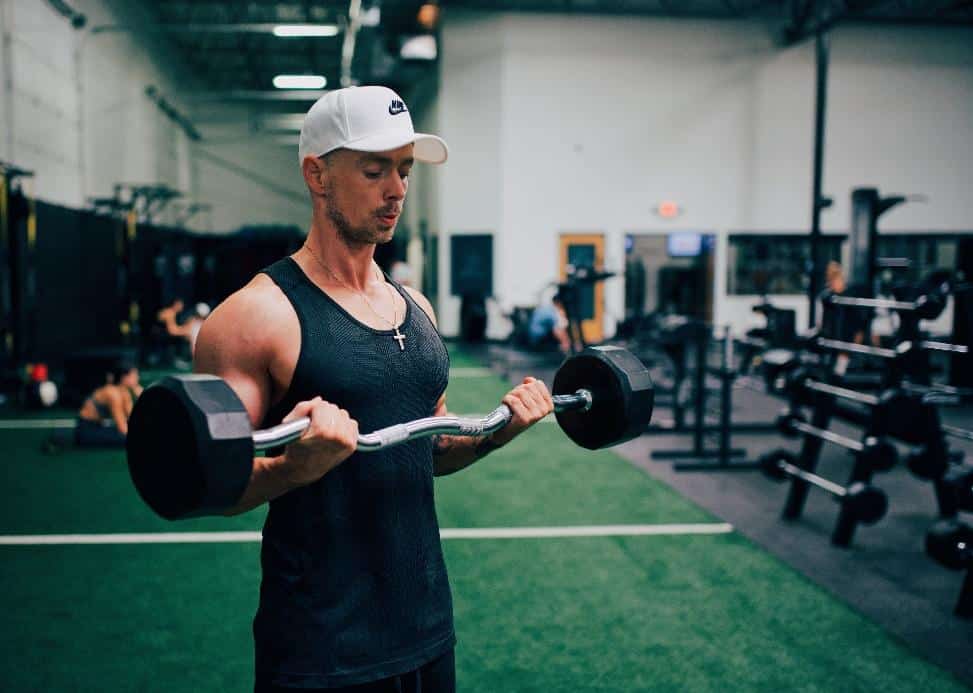
The biceps brachii occupies 48% of the arm’s volume, with 35% being the brachialis muscle and 17% the brachioradialis muscle (Winters & Stark, 1988). However, all of this is concentrated when we say that we are going to train our biceps, and that’s how we will refer to the biceps brachii throughout the article. When performing weight training for arms with the goal of stimulating the biceps, we engage in a primary movement: elbow flexion. In addition to that movement, the biceps also performs arm supination, meaning it rotates our hand outward (Taylor & O’Brien, 2016).
You can feel this movement by flexing your elbow to 90 degrees while looking at the back of your hand. From there, rotate your arm so that instead of seeing the back of your hand, you see the palm. In free-weight exercises like the bicep curl, we can perform both movements: elbow flexion and arm rotation. What distinguishes one biceps exercise from another if they all involve the same movement?
[banner_device_2]
While training the biceps, we always perform the same movement, but there are some differences that will activate one head or another, or one area of the muscle or another. If you want to optimize your weight training for arms, you must consider the differences between these subtle positions that generate significant benefits for the biceps. This way, you can master bicep training and build muscle mass more quickly and evenly.
Elbow Position Concerning Trunk, Affects Stimulus Received By the Biceps
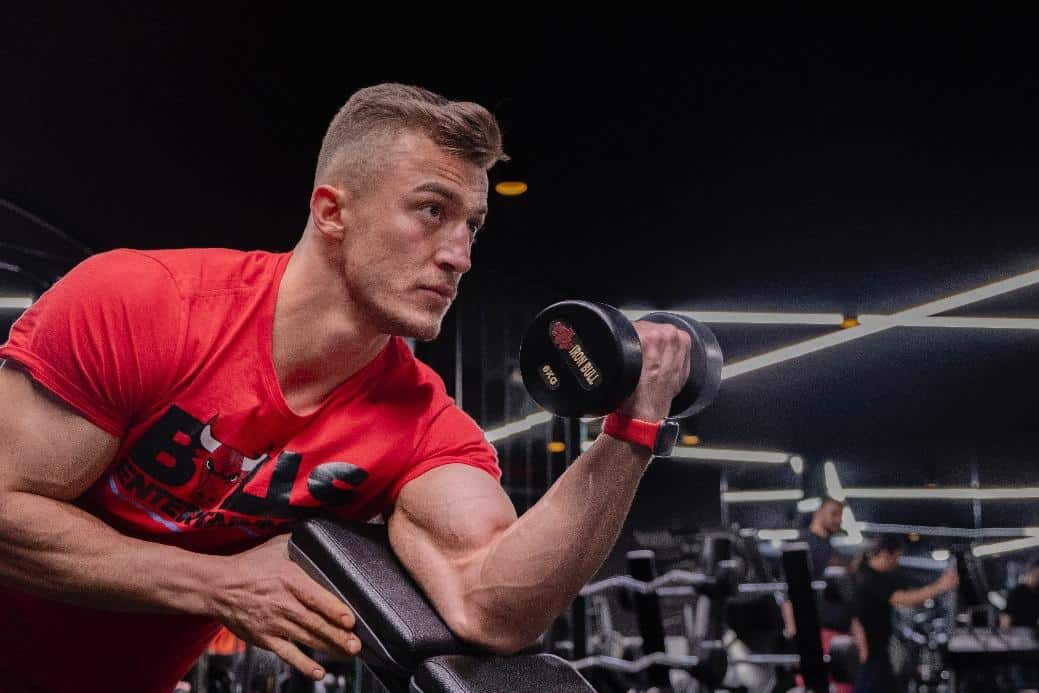
Even if you always perform elbow flexion with or without arm supination, changing the position of the elbow concerning the trunk will activate the biceps differently. The three positions of the elbow concerning the trunk are: elbows in front of the trunk, elbows close to the sides, and elbows behind the torso. Each of these arm positions will make our muscle group work more in the initial part of the exercise, the middle of the range, or the final part of the repetition.
Although both heads of the biceps activate simultaneously regardless of the elbow position, we can stimulate one more than the other and target a region closer to the elbow, closer to the shoulder, or in-between. The short head of the biceps is slightly more activated when the elbows are close to the sides and in exercises with shoulder flexion, i.e., when the elbows are in front of the torso. The long head has greater activation when performing elbow flexion with the elbows behind the sides (Levy et al., 2001).
Resistance Curves According to Elbow Position in Relation to the Trunk
The resistance curves are the lines that depict muscle tension during an exercise. In the case of biceps exercises, as shown in the image below, a seated incline bench bicep curl (elbows behind the trunk) has an ascending resistance curve, while a bicep curl with the arm supported on the bench (elbows in front of the trunk) has a descending resistance curve (Zabaleta-Korta et al., 2023). In the first case, the tension goes from less to more, and in the second exercise, it goes from more to less.
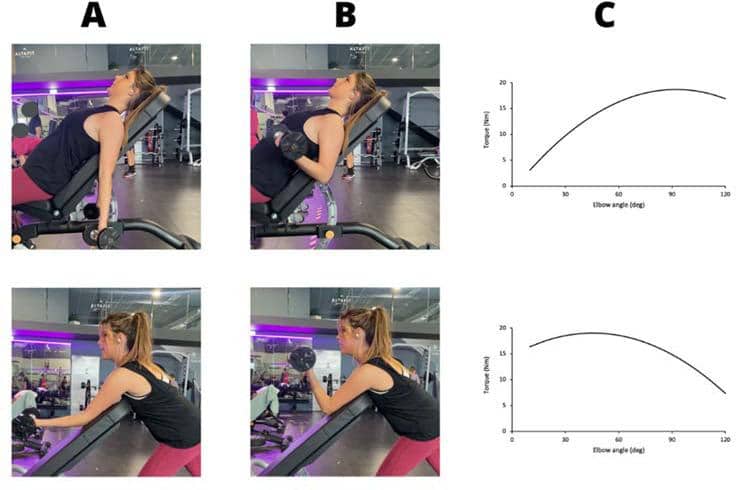
In between the two previous exercises is the typical bicep curl (elbows close to the sides), which has a bell-shaped resistance curve. In this exercise, tension first increases until the arms are at 90 degrees, the moment of maximum tension, and from there, tension decreases as the load approaches the shoulder. The stimulus in these three exercises will be different due to the position of the elbows concerning the trunk.
For this reason, the key takeaway is to combine exercises with different resistance curves to accumulate peaks of maximum tension at different parts of the elbow flexion, making the sessions of much higher quality. The peak of maximum tension will be at the end of the exercise when the elbows are in front of the body; the peak of maximum tension will be in the middle of the movement when the elbows are close to the sides; and the peak of maximum tension will occur at the beginning of the movement in exercises with the elbows behind the torso, although there may be exceptions depending on the type of load used and body position.
Other Details To Manage in Arm Weight Training to Get The Most Out of Bicep Stimulus
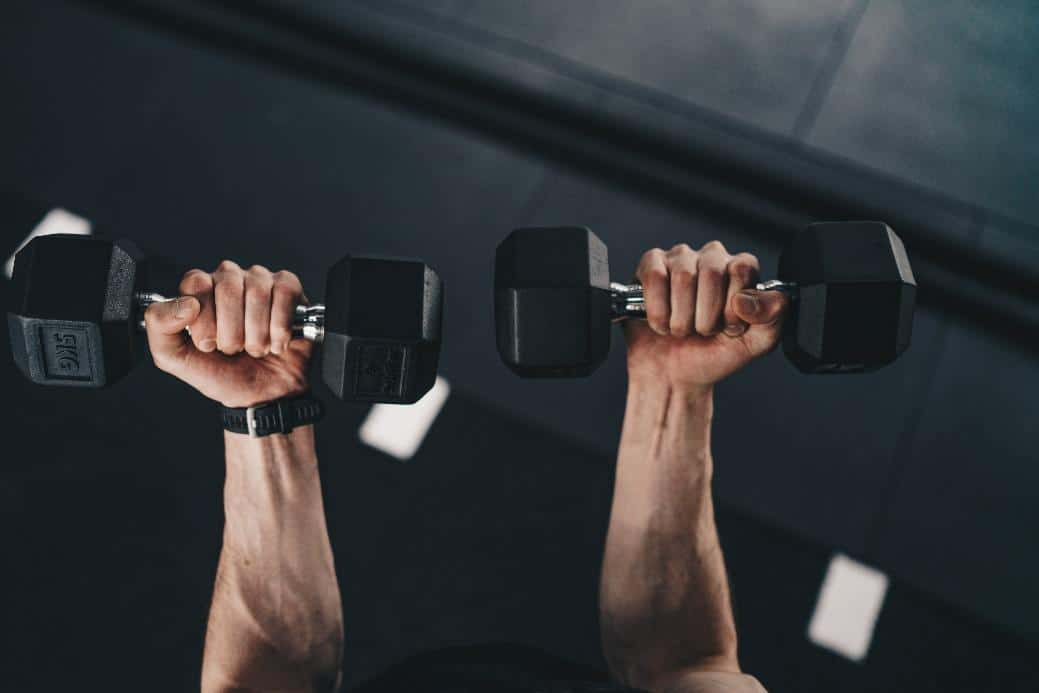
The type of grip also affects the stimulus received by the biceps: pronated, supinated, or neutral grip.
Bicep exercises can be performed with the palms facing upward (pronated grip), with the palms facing each other (neutral grip), or with the palms facing downward (supinated grip). Both heads of the biceps will activate simultaneously, but if we use a neutral or pronated grip, the short head will be slightly more activated. To emphasize the long head a bit more, the supinated grip will be the most interesting, and all of this will also depend on the elbow position concerning the torso, as we saw in the previous section.
[banner_guide]
The eccentric phase is crucial for biceps in arm weight training.
Each repetition in a set consists of three types of contractions or phases: eccentric, isometric or transitional, and concentric. In bicep exercises, the eccentric phase is when the arm is lengthening against the resistance that is pushing us. Several studies in scientific literature have shown that the eccentric phase is crucial in bicep training, so we should perform this part of the movement slowly and controlled (Sato et al., 2022).
This phase is so important that just three seconds of eccentric contraction per day, repeated frequently, can induce strength and muscle mass gains in the biceps (Yoshida et al., 2023). That is why, to master arm weight training, you should not overlook the eccentric phase, as is often the case with many athletes.
Master Arm Weight Training with These Bicep Exercises
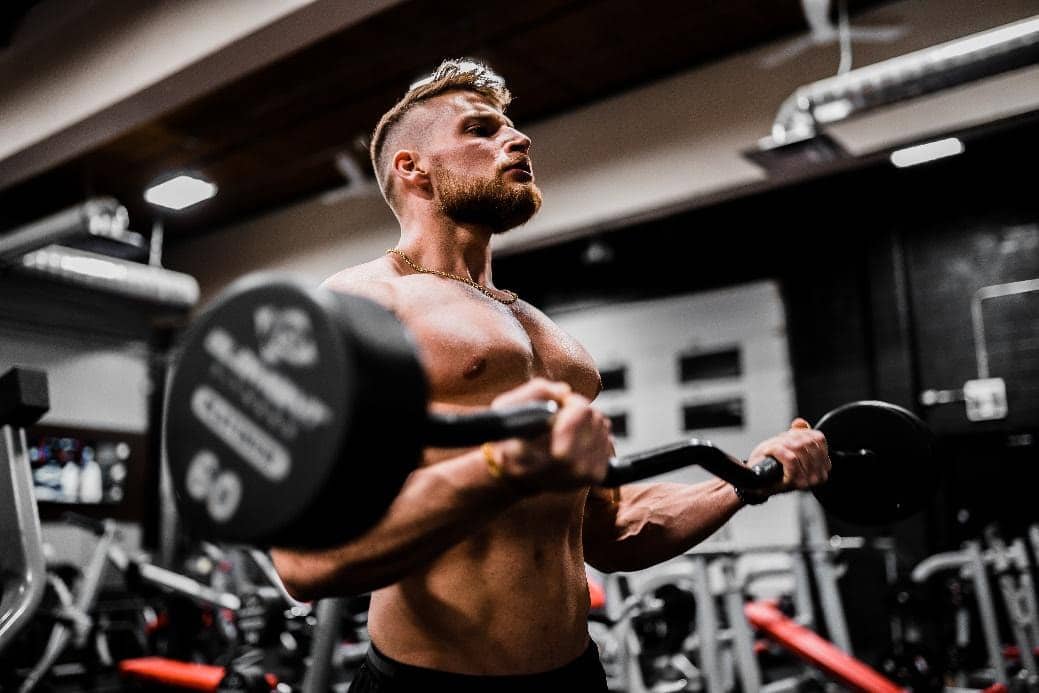
There are dozens of bicep exercises. The goal is not to list them all but to simply categorize some of them into the different groups we discussed earlier based on shoulder position, thus creating varying muscle tension in our sessions
Shoulder in Flexion: Elbows in Front of the Torso
Shoulder in Anatomical Position: Elbows Close to the Torso
Shoulder in Extension: Elbows Behind the Torso
Brief Anatomy of the Triceps Brachii
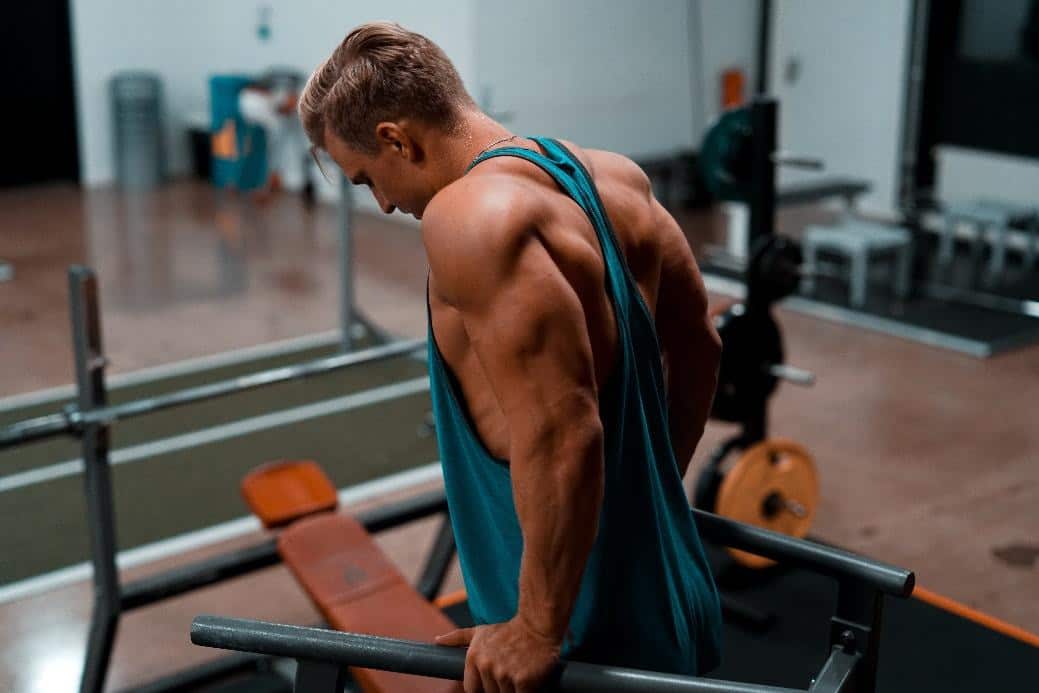
If the biceps owes its name to its two heads, the triceps does the same with its three heads (tri = three; ceps = heads). Training for the back of the arms follows the same dynamic as the biceps, as although the extension of the elbow activates all three heads simultaneously, the position of the elbow will determine whether we emphasize one or the other (Le Bozec et al., 1980). Throughout the article, when we refer to the triceps, we mean the triceps brachii for easier reading.
When training the triceps, there is a detail that cannot go unnoticed: one of its heads is biarticular. The long head of the triceps is involved in both elbow and shoulder movements (two joints), so it depends on both hinges. The other two heads, the short head, and the lateral head only act when the elbow moves, but the position of the arm also affects their activity. The triceps behaves similarly to the biceps, so we will apply what we have discussed earlier in the sessions.
The Position of the Elbows in Relation to the Trunk and Its Direct Impact on Triceps Stimulation
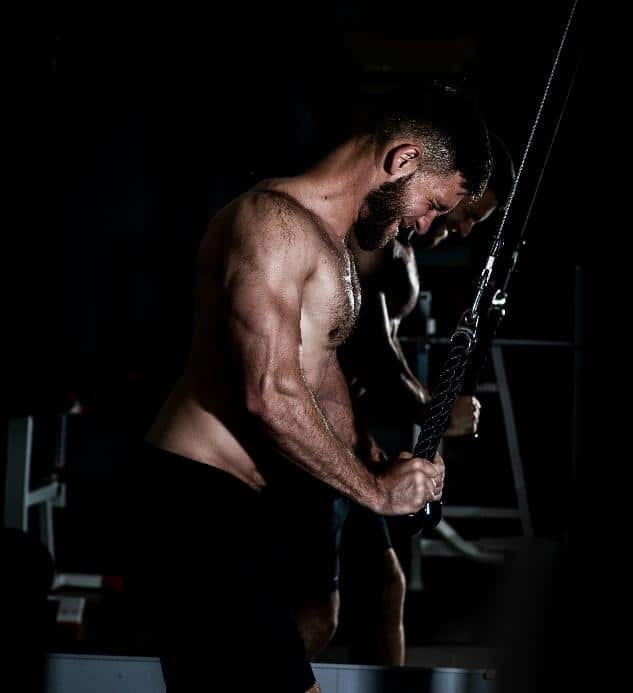
The long head is more activated in exercises where the elbows are in front of the body. The medial and lateral heads are more activated when the elbows are close to the sides and when the elbows are behind the torso (Ali et al., 2015). That’s why our triceps sessions should include exercises in all three elbow positions relative to the torso, making the stimulus much more comprehensive (Alves et al., 2018).
For triceps exercises, we can add one more elbow position compared to what we discussed for biceps. Arm training with weights with the goal of maximizing triceps stimulation should include these four arm positions relative to the torso: elbows at the sides of the head, elbows in front of the torso, elbows close to the sides, and elbows behind the torso. While the position of elbows at the sides of the head is technically within the category of elbows in front of the torso, we’ll differentiate them because scientific literature has confirmed the significant role of triceps stretching in inducing greater hypertrophy (Maeo et al., 2023).
Exercises above the head are essential if you want to stimulate the triceps to the fullest
There is a phenomenon known as stretch-induced hypertrophy, emphasizing the importance of stretching the muscle under load to maximize muscle mass gains (Warneke et al., 2023). That’s why various researchers have found greater muscle growth in the triceps with exercises where the shoulder is fully flexed, meaning the elbows are next to the head (Maeo et al., 2023). In the following image, you can see in position E) what we mean by “exercises above the head.
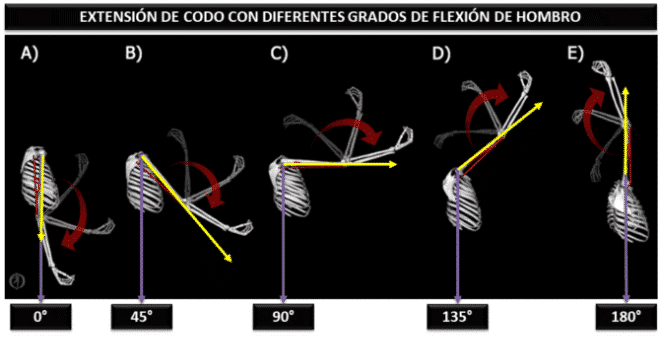
Previously, we emphasized that the long head of the triceps is biarticular, stretching to the maximum in the position with elbows at the sides of the head, thus generating the mentioned stretch-induced hypertrophy. Does that mean we should only perform triceps exercises with this arm position? No, but we should give more importance to these movements in our triceps sessions to maximize gains.
Master Arm Training with these Triceps Exercises
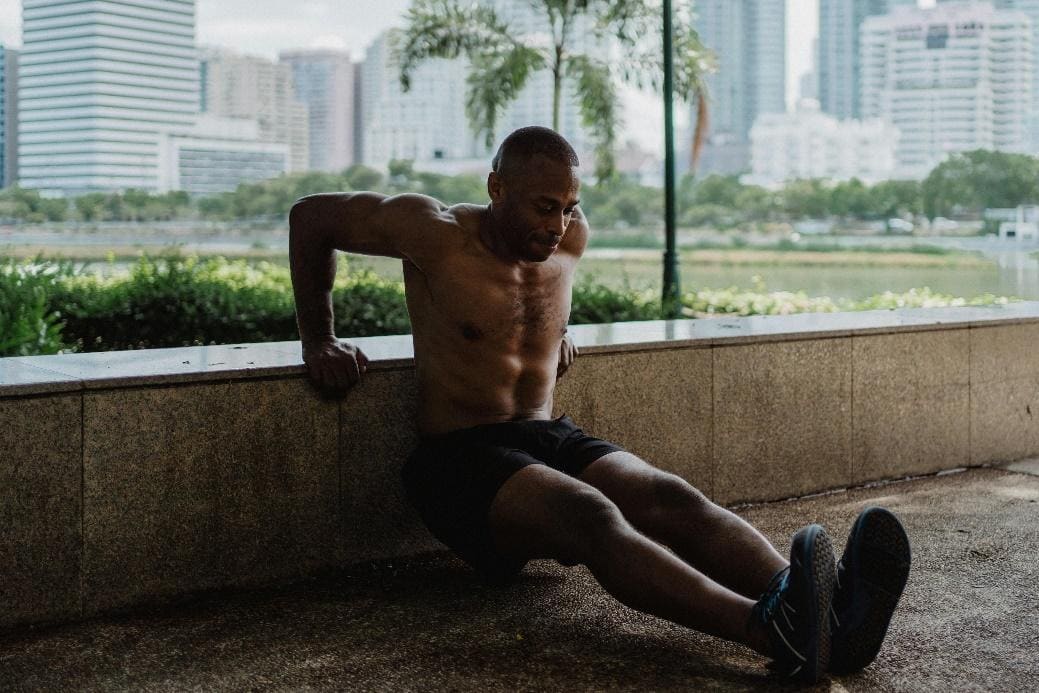
There are dozens of triceps exercises. The goal is not to list them all but to simply categorize some of them into the different groups we discussed earlier based on shoulder position, thus creating varied muscle tension in our training sessions.
Shoulder in maximum flexion: elbows to the sides of the head
Shoulder in flexion: elbows in front of the torso
Shoulder in anatomical position: elbows close to the sides
- Press Down en polea alta (press down)
Shoulder in extension: elbows behind the torso
At the Gym
“Weight training for arms is as simple as it is complex, as we stimulate the biceps and triceps through flexion and extension of the elbow. However, there are many nuances that make this gesture entirely different. To master weight training for arms, you must be aware of the difference in stimulus generated based on the position of elbows in relation to the torso, technically known as shoulder flexion or extension. Additionally, the hand position when gripping the load and the eccentric phase will also determine whether the weight training for arms is of higher or lower quality.
Stimulate your biceps and triceps with exercises in different arm positions detailed throughout the article (elbows in front of the torso, elbows close to the sides, and elbows behind the torso). Execute the eccentric phase slowly to promote stretch-induced hypertrophy, and vary the types of loads and speeds used. By combining all these elements, your sessions will be of much higher quality than if you don’t take them into account.
[banner_device_1]
References
Ali, M. A., Sundaraj, K., Ahmad, R. B., Ahamed, N. U., Islam, M. A., & Sundaraj, S. (2015). Muscle Fatigue in the Three Heads of the Triceps Brachii During a Controlled Forceful Hand Grip Task with Full Elbow Extension Using Surface Electromyography. Journal of Human Kinetics, 46(1), 69–76. https://doi.org/10.1515/HUKIN-2015-0035
Alves, D., Matta, T., & Oliveira, L. (2018). Effect of shoulder position on triceps brachii heads activity in dumbbell elbow extension exercises. The Journal of Sports Medicine and Physical Fitness, 58(9), 1247–1252. https://doi.org/10.23736/S0022-4707.17.06849-9
Kholinne, E., Zulkarnain, R. F., Sun, Y. C., Lim, S. J., Chun, J. M., & Jeon, I. H. (2018). The different role of each head of the triceps brachii muscle in elbow extension. Acta Orthopaedica et Traumatologica Turcica, 52(3), 201. https://doi.org/10.1016/J.AOTT.2018.02.005
Le Bozec, S., Maton, B., & Cnockaert, J. C. (1980). The synergy of elbow extensor muscles during dynamic work in man. I. Elbow extension. European Journal of Applied Physiology and Occupational Physiology, 44(3), 255–269. https://doi.org/10.1007/BF00421625
Levy, A. S., Kelly, B. T., Lintner, S. A., Osbahr, D. C., & Speer, K. P. (2001). Function of the long head of the biceps at the shoulder: electromyographic analysis. Journal of Shoulder and Elbow Surgery, 10(3), 250–255. https://doi.org/10.1067/MSE.2001.113087
Maeo, S., Wu, Y., Huang, M., Sakurai, H., Kusagawa, Y., Sugiyama, T., Kanehisa, H., & Isaka, T. (2023). Triceps brachii hypertrophy is substantially greater after elbow extension training performed in the overhead versus neutral arm position. European Journal of Sport Science, 23(7), 1240–1250. https://doi.org/10.1080/17461391.2022.2100279
Sato, S., Yoshida, R., Murakoshi, F., Sasaki, Y., Yahata, K., Nosaka, K., & Nakamura, M. (2022). Effect of daily 3-s maximum voluntary isometric, concentric, or eccentric contraction on elbow flexor strength. Scandinavian Journal of Medicine & Science in Sports, 32(5), 833–843. https://doi.org/10.1111/SMS.14138
Taylor, S. A., & O’Brien, S. J. (2016). Clinically Relevant Anatomy and Biomechanics of the Proximal Biceps. Clinics in Sports Medicine, 35(1), 1–18. https://doi.org/10.1016/j.csm.2015.08.005
Warneke, K., Lohmann, L. H., Lima, C. D., Hollander, K., Konrad, A., Zech, A., Nakamura, M., Wirth, K., Keiner, M., & Behm, D. G. (2023). Physiology of Stretch-Mediated Hypertrophy and Strength Increases: A Narrative Review. Sports Medicine (Auckland, N.Z.), 53(11). https://doi.org/10.1007/S40279-023-01898-X
Winters, J. M., & Stark, L. (1988). Estimated mechanical properties of synergistic muscles involved in movements of a variety of human joints. Journal of Biomechanics, 21(12), 1027–1041. https://doi.org/10.1016/0021-9290(88)90249-7
Yoshida, R., Kasahara, K., Murakami, Y., Sato, S., Tanaka, M., Nosaka, K., & Nakamura, M. (2023). Weekly minimum frequency of one maximal eccentric contraction to increase muscle strength of the elbow flexors. European Journal of Applied Physiology, 3, 1–11. https://doi.org/10.1007/S00421-023-05281-6/FIGURES/6
Zabaleta-Korta, A., Fernández-Peña, E., Torres-Unda, J., Francés, M., Zubillaga, A., & Santos-Concejero, J. (2023). Regional Hypertrophy: The Effect of Exercises at Long and Short Muscle Lengths in Recreationally Trained Women. Journal of Human Kinetics, 87, 259. https://doi.org/10.5114/JHK/163561
